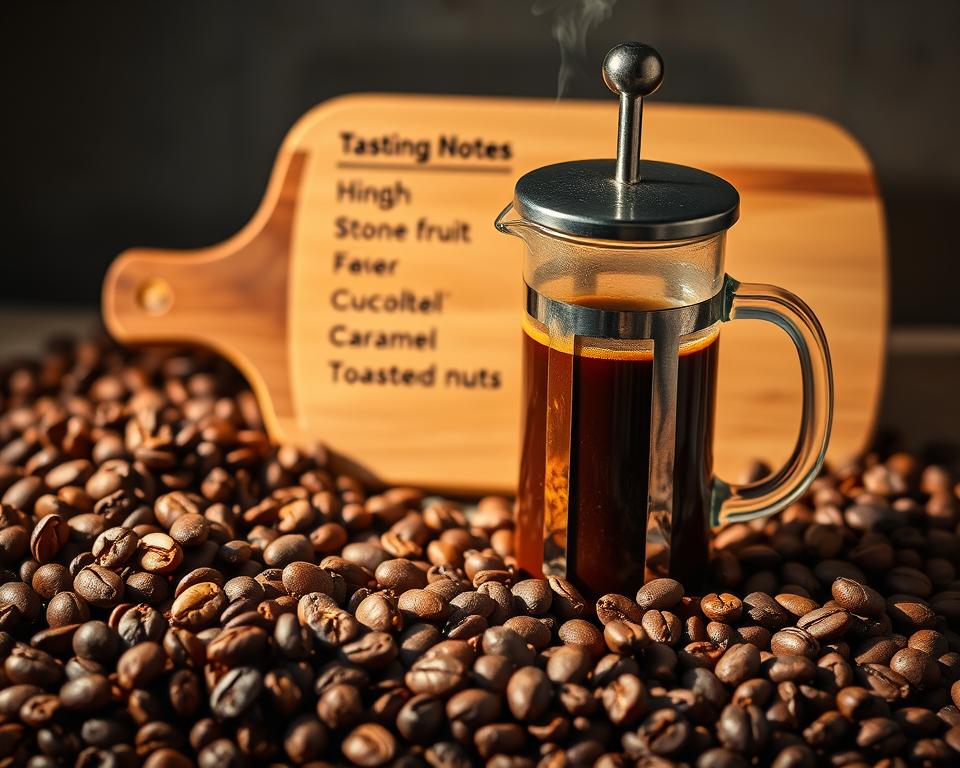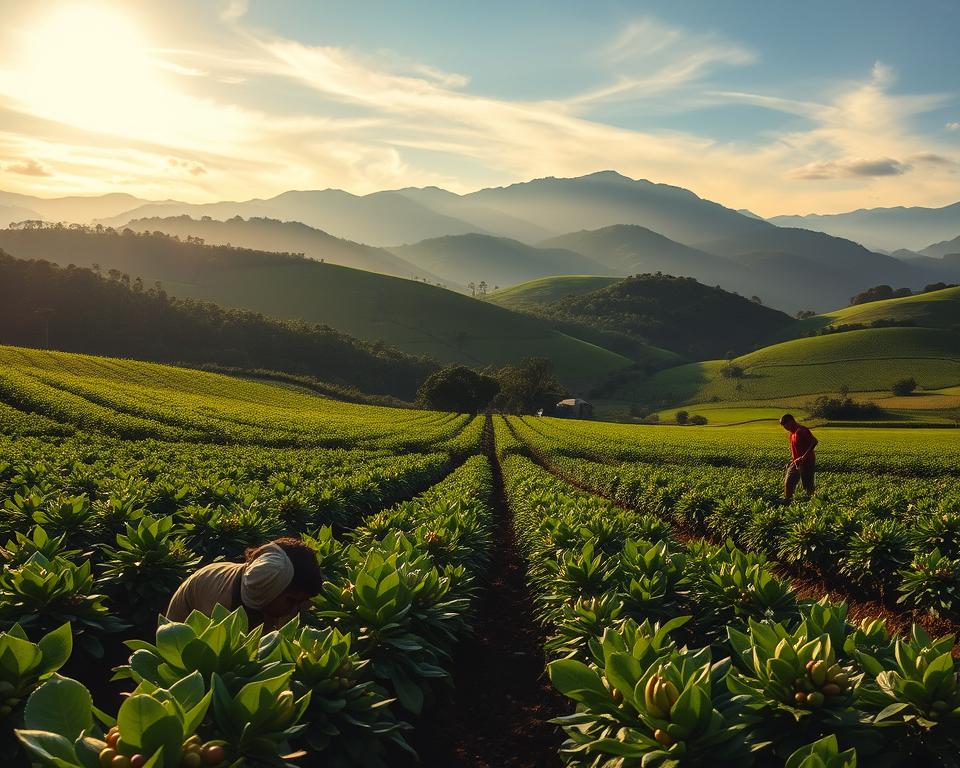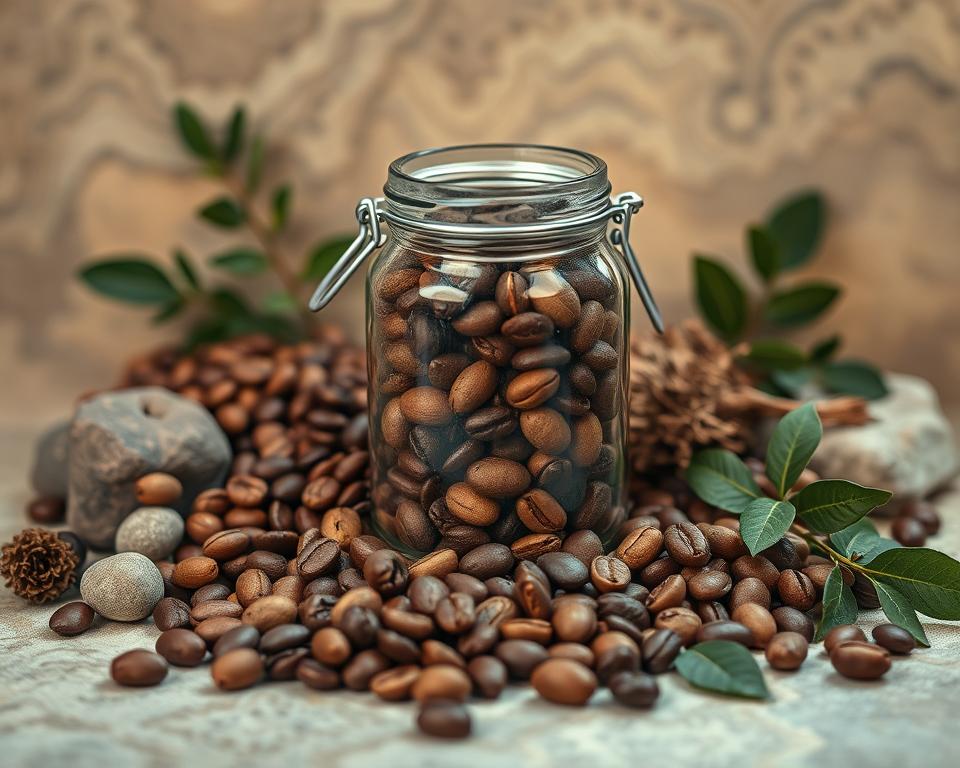Coffee flavors are shaped by the unique environmental factors of a coffee-growing region, known as terroir. Terroir coffee flavors vary due to soil, climate, and elevation. This understanding is key to appreciating coffee’s diverse flavors, from Ethiopian coffees’ bright acidity to Brazilian coffees’ rich, chocolatey notes.
The concept of terroir is vital in determining coffee quality and taste. Arabica beans, making up 60-70% of global production, are renowned for their high-quality flavor profiles. Roast level, water temperature, and coffee-to-water ratio also impact coffee flavors, making terroir coffee flavors complex and multifaceted.
Coffee flavor profiles are influenced by the environmental conditions of cultivation. Latin American coffees, with a pH of 4.5-5.0, exhibit bright acidity. African coffees, with a higher acidity level, showcase vibrant tastes and complex flavor notes. These are distinct terroir coffee flavors.
Key Takeaways
- Terroir plays a significant role in shaping coffee flavor profiles.
- Arabica beans are considered higher-quality and produce better coffee flavor profiles.
- The roast level, water temperature, and coffee-to-water ratio influence the flavor profiles of coffee.
- Coffee tasting notes are unique to each region and are shaped by the specific environmental conditions.
- Understanding terroir is essential for appreciating the diversity of flavors in coffee.
What is Terroir in Coffee?
Coffee terroir is the unique blend of environmental elements like soil, climate, and elevation that shape coffee’s flavor. Specialty coffee origins boast distinct terroir profiles, leading to unique coffee flavors. The finest terroirs are found in areas with high altitudes, rich soil, and ideal climates.
Terroir encompasses more than just environmental aspects; it also includes human influences like farming and processing methods. These human factors significantly alter coffee’s flavor, making them crucial in evaluating best coffee terroirs. For example, coffee grown at high altitudes often boasts a more intricate flavor compared to lower-altitude coffee.
Defining Terroir and Its Importance
Terroir is a key determinant of coffee quality and taste. Grasping the concept of terroir and its role in shaping coffee flavor is vital for appreciating the distinct qualities of specialty coffee origins.
How Terroir Influences Taste
The terroir of a region profoundly impacts coffee’s taste. Soil type, climate, and elevation all play roles in shaping coffee’s flavor, leading to unique coffee flavors. For instance, coffee from regions with rich volcanic soil often exhibits a brighter acidity and more complex taste.
Regions Known for Unique Terroirs
Several regions stand out for their unique terroirs, including Ethiopia, Kenya, and Colombia. These areas combine environmental factors to create best coffee terroirs and unparalleled coffee flavors. Coffee aficionados can better appreciate their favorite beans by understanding the terroir of these regions.
The Role of Climate in Coffee Flavor Profiles
Coffee’s aroma is deeply influenced by climate, with the best conditions resulting in richer, more balanced flavors. Single origin coffees, in particular, reflect the unique climate of their region. For example, areas with clear wet and dry seasons, such as parts of Africa and Latin America, produce coffees with distinct flavors. This is due to the seasonal changes in rainfall and sunlight.
Temperature and rainfall are key to coffee growth, with ideal climate conditions yielding denser beans with complex sugars and nuanced flavors. Rainfall’s impact on flavor is significant, with consistent patterns crucial for coffee cherry development. Dry periods, on the other hand, are necessary for harvesting. Unpredictable weather patterns from climate change can disrupt flavor and quality consistency.
Temperature and Coffee Growth
Coffee plants grown in cooler mountainous regions mature more slowly. This results in denser beans with complex sugar structures and nuanced flavors. In contrast, beans from warmer tropical climates are lighter and fruitier compared to those from cooler regions.
Effects of Rainfall on Flavor
Rainfall patterns significantly shape the flavor profiles of single origin coffees. Regions with high rainfall tend to produce coffees with brighter acidity and more pronounced flavors.
Seasonality in Coffee Production
Climate also influences seasonality in coffee production, with different regions experiencing unique seasonal patterns. Understanding these patterns is crucial for producing high-quality coffees with distinct flavor profiles.
Soil Composition: A Flavor Game-Changer
The type of soil where coffee plants grow greatly impacts the coffee’s flavor. Soils vary in nutrients and minerals, which coffee plants absorb. This affects the flavor of the beans. For example, volcanic soils in Yirgacheffe, Ethiopia, lead to brighter acidity and fruit notes. In contrast, clay soils result in earthier, more balanced flavors.
Types of Soil and Their Impact on Coffee
Volcanic soils, like those in Yirgacheffe, are mineral-rich, enhancing coffee’s flavor. Other soils, such as clay or sandy, also influence coffee taste. Each soil type’s unique nutrient mix leads to diverse artisanal coffee flavors.
Nutrient Variations Across Regions
Nutrient levels in soil differ across regions, shaping coffee flavor profiles. High phosphorus levels can create complex flavors. Low potassium levels result in brighter acidity. Grasping soil’s role in coffee flavor is key for crafting unique artisanal coffee flavors.
Elevation and Its Influence on Coffee Taste
Coffee elevation significantly impacts the flavor profile of coffee beans. Higher elevations often produce coffees with complex, nuanced flavors. In contrast, lower elevations yield coffees with a balanced taste. The slower maturation at high altitudes allows for more concentrated sugars, enhancing the sweetness in high-altitude coffee.
High-altitude coffee is known for its distinct characteristics:
- Brighter acidity, often described as vibrant and complex
- More pronounced sweetness, with fruity or floral notes
- Intricate flavor profiles, with notes of citrus, berries, and hints of spices
Lower-altitude coffee, on the other hand, has lower acidity due to warmer temperatures and faster maturation. Yet, it offers a well-rounded, balanced taste that appeals to a wide audience. The best coffee terroirs are typically found at higher elevations. Here, the unique combination of climate, soil, and altitude imbues the coffee beans with a distinctive character, leading to unique flavors.
Connoisseurs often seek high-altitude coffee for its complex taste variations. These variations stem from the slower maturation process and the resulting more concentrated sugars. The optimal humidity levels for coffee growth, usually between 60-70%, also contribute to more complex flavors. Elevation is a key factor in coffee flavor profiles. Understanding its influence helps coffee enthusiasts appreciate the unique qualities of their favorite brews.
| Elevation | Acidity | Sweetness | Flavor Profile |
|---|---|---|---|
| High | Brighter | More pronounced | Intricate, with notes of citrus and berries |
| Low | Lower | Less pronounced | Well-rounded, balanced |
Processing Methods and Terroir
Coffee processing methods are crucial in defining coffee flavors, notably in specialty coffee origins. The processing technique can either highlight or hide the terroir’s attributes, influencing the coffee’s taste. For example, naturally processed coffees often have fruitier and more robust flavors. In contrast, washed coffees are brighter and more tea-like, showcasing the terroir’s effect on flavor.
Exploring coffee processing methods reveals how natural and washed processing differ in flavor impact. Natural processing, where cherries dry with the fruit intact, yields complex flavors. Washed processing, which removes the skin and pulp, results in cleaner, brighter tastes. This underscores the significance of processing methods in shaping coffee’s flavor.
Difference Between Natural and Washed Processing
The processing method significantly influences coffee flavor profiles by introducing new flavors or enhancing terroir characteristics. Honey-processed coffee, for instance, boasts a distinct taste, often described as honey-like. This unique flavor comes from the partial removal of the coffee cherry’s skin and pulp, creating a sweet and complex taste.
How Processing Highlights Terroir Characteristics
In specialty coffee origins, processing methods also highlight terroir traits. High-altitude coffee tends to have complex flavors due to slower maturation. In contrast, coffee from lower altitudes often has brighter, more acidic flavors. Grasping how processing affects flavor is key to appreciating specialty coffee’s unique qualities.
The Importance of Coffee Variety
Coffee variety significantly influences the flavor profile, with each variety showcasing unique traits influenced by terroir. The type of coffee plant greatly affects the taste, leading to varied flavor profiles.
Environmental factors like temperature, rainfall, and soil composition also shape these flavors. For example, coffee grown at high altitudes matures slower. This slower maturation allows for more complex flavor absorption, resulting in distinct terroir coffee flavors.
Arabica vs. Robusta: Flavor Comparisons
Arabica and Robusta are the primary coffee species, with Arabica being more sensitive to its environment and having a more delicate taste. Within Arabica, there are many varieties, each capable of producing distinct flavor profiles and tasting notes.
Unique Varietals and Their Terroir-Specific Qualities
Regions like Ethiopia are famous for their heirloom varieties, contributing to the unique flavors of their coffees. These varieties have adapted to the local terroir, resulting in distinct flavor profiles shaped by the region’s terroir coffee flavors.

Crafting Flavor Profiles Through Selective Breeding
Selective breeding aims to enhance desirable traits like disease resistance and flavor quality. This process diversifies coffee flavors and results in unique tasting notes. By understanding the importance of coffee variety and its impact on terroir, producers can craft distinct flavor profiles. These profiles showcase the unique characteristics of their region.
| Coffee Variety | Terroir Coffee Flavors | Coffee Tasting Notes |
|---|---|---|
| Arabica | Delicate, complex | Fruity, floral |
| Robusta | Harsh, bitter | Earthly, rubbery |
Exploring Flavor Notes Associated with Terroir
Coffee aroma and single origin flavors are deeply tied to the terroir of their growth region. Terroir includes environmental factors like soil, altitude, climate, and topography. These elements shape the coffee’s flavor profile.
Ethiopian Yirgacheffe coffee stands out with its bright acidity and lively floral notes. It also has hints of citrus, creating a complex taste. On the other hand, Colombian Supremo coffee boasts a medium body and smooth finish. It offers hints of nuts and chocolate, appealing to many.
Here are some common flavor profiles tied to different regions:
- Ethiopian coffees: fruity and floral notes
- Kenyan coffees: bright acidity and complex flavors, including blackcurrant and citrus
- Brazilian coffees: smoother, balanced taste with nut hints
Understanding these regional flavors helps coffee lovers appreciate terroir’s influence. Recognizing the unique aromas and flavors of each region allows for informed choices. It opens up the rich world of specialty coffee.
| Region | Flavor Profile |
|---|---|
| Ethiopia | Fruity and floral notes |
| Kenya | Bright acidity and complex flavors |
| Brazil | Smaller, balanced flavor with nut hints |
Terroir and Sustainability in Coffee Farming
Coffee farming significantly affects the environment and local economies. Practices like shade-grown cultivation and minimal intervention boost the complexity and balance of artisanal coffee flavors. It’s vital to support local economies through sustainable farming to preserve the unique tastes of various specialty coffee origins.
The relationship between terroir, sustainability, and flavor is complex. Sustainable farming maintains the environmental conditions that create distinct flavors. For example, coffee grown at high elevations, like in the Andes, has a sweet, acidic, and complex taste. On the other hand, warmer climates produce lighter, fruitier flavors.

To foster sustainability in coffee farming, supporting local economies and adopting eco-friendly practices is key. Initiatives like fair trade, organic farming, and reforestation are crucial. These efforts ensure coffee’s long-term sustainability and protect the unique terroirs that offer us the rich variety of artisanal coffee flavors and specialty coffee origins we love.
Tasting Coffee with Terroir in Mind
Exploring coffee terroir can revolutionize your tasting experience, turning each sip into a journey of discovery. By grasping how unique growing conditions and production methods craft unique coffee flavors, you gain a deeper appreciation for the craftsmanship and stories behind your favorite coffee brands.
Begin by sharpening your senses – focus on the subtle differences in aroma, acidity, body, and sweetness that mirror the best coffee terroirs. Consider the climate, soil, and elevation of the region. These factors significantly influence the distinct coffee flavor profiles. Venture into the world of coffee, from the floral and citrusy Ethiopian beans to the rich, chocolatey Central American coffees.
To further enhance your tasting adventure, travel to coffee-producing countries. Immerse yourself in the local culture and visit the farms directly. See the sustainable practices that protect terroir and boost local economies. Discover the passion and creativity of small-batch roasters who celebrate the unique flavors of their terroir-inspired coffee.
FAQ
What is terroir in the context of coffee?
How does terroir influence the taste of coffee?
What are some coffee-producing regions known for their distinctive terroirs?
How does climate affect the flavor of coffee?
How does the type of soil impact the taste of coffee?
How does elevation affect the taste of coffee?
How do processing methods impact the expression of terroir in coffee?
How do different coffee varieties contribute to terroir-specific flavor profiles?
How can one identify the influence of terroir in a cup of coffee?
How does the preservation of unique terroirs relate to the sustainability of coffee production?

Paul Allen is a writer at WyNeeds, a website dedicated to the world of coffee. Passionate about aromas and flavors, he explores everything from the best brewing methods to fascinating insights about coffee beans and industry trends. His goal is to provide readers with engaging and informative content, helping both beginners and coffee enthusiasts deepen their knowledge of the world’s most beloved beverage.

